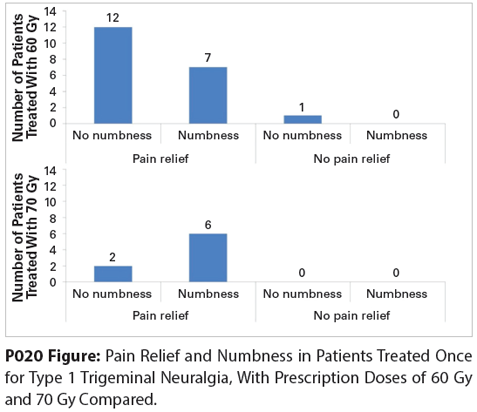(P020) The Effect of Dose on Pain Relief and Numbness With Robotic Stereotactic Radiosurgery for Trigeminal Neuralgia
CyberKnife stereotactic radiosurgery (SRS) is a minimally invasive alternative for patients with trigeminal neuralgia (TN). The purpose of this project is to determine the effects of dose and other clinical parameters on the rate of pain relief, duration of response, and rate of adverse effects in the treatment of TN using CyberKnife SRS.
P020 Figure

Dana H. Chung, Francis S. Cardinale, MD, Isaac Goodrich, MD, Shane Lloyd, MD; Yale University School of Medicine; Connecticut Neuroscience
Purpose: CyberKnife stereotactic radiosurgery (SRS) is a minimally invasive alternative for patients with trigeminal neuralgia (TN). The purpose of this project is to determine the effects of dose and other clinical parameters on the rate of pain relief, duration of response, and rate of adverse effects in the treatment of TN using CyberKnife SRS.
Methods: Between October 2008 and April 2012, 56 patients were treated with 66 courses (including 10 re-treatments) of CyberKnife SRS for classical (idiopathic) TN at our institution. Of the 66 SRS courses, 22 were prescribed to 70 Gy (Dmax 86 Gy), 37 were prescribed to 60 Gy (Dmax 74 Gy), and 6 were prescribed to 50 Gy (Dmax 62 Gy). Clinical characteristics were retrospectively retrieved from the medical record. Pain level was documented at consultation and at follow-up, and adverse effects were recorded at follow-up. Logistic regression was used to test for correlations of clinical parameters, including dose, gender, age, pretreatment pain level, treatment order (first or second), and TN type, with the rates of pain relief and adverse effects. We also described the characteristics of patients who achieved an “optimal outcome” (continued pain relief with no numbness at 12 months).
Results: The median follow-up was 15 months. Of 66 treatments administered, 57 (86%) resulted in pain relief. Twenty-six patients (46%) had pain relief with no recurrence at last follow-up. A higher rate of pain relief was seen in patients with typical, type 1 TN features (P = .05). The other parameters tested, including dose (P = .15), did not correlate with response rates. The actuarial median duration of pain relief was 21 months. Thirty patients (54%) experienced mild (16%), moderate (18%), or severe (20%) facial numbness at last follow-up. Other side effects were not seen. There was a trend toward lower rates of numbness in patients treated with 60 Gy compared with 70 Gy (P = .07). In patients treated only once, the relative numbers of patients with pain relief and numbness are shown below by prescription dose. Ten patients with sufficient follow-up had an optimal outcome. Of these, all had type 1 TN, seven were treated to 60 Gy, and eight had severe pretreatment pain (Barrow Neurological Institute [BNI] V).
Conclusions: CyberKnife SRS is safe and effective for the treatment of trigeminal neuralgia. A prescription dose of 60 Gy provides similar pain relief to higher doses, with a trend toward decreased numbness. The majority of patients who achieved an optimal outcome received 60 Gy. This study is among the largest to demonstrate effectiveness with this low-dose SRS.
Newsletter
Stay up to date on recent advances in the multidisciplinary approach to cancer.